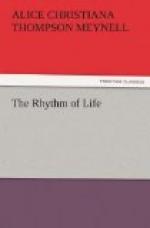But there is one conspicuous thing in the world to which man has not served as a unit of proportion, and that one thing is a popularly revered triumph of that very art of architecture in which Mr. Oscar Wilde has confidence for keeping things in scale. Human ingenuity in designing St. Peter’s on the Vatican, has achieved this one exception to the universal harmony—a harmony enriched by discords, but always on one certain scale of notes—which the body makes with the details of the earth. It is not in the landscape, where Mr. Oscar Wilde has too rashly looked for contempt and contumely, but in the art he holds precious as the minister to man’s egotism, that man’s Ego is defied. St. Peter’s is not necessarily too large (though on other grounds its size might be liable to correction); it is simply out of relation to the most vital thing on the earth—the thing which has supplied some secret rod to measure the waves withal, and the whales, the sea-wall cliffs, the ears of wheat, the cedar-branches, pines and diamonds and apples. Now, Emerson would certainly not have felt the soft shock and stimulus of delight to which he confesses himself to be liable at the first touch of certain phrases, had not the words in every case enclosed a promise of further truth and of a second pleasure. One of these swift and fruitful experiences visited him with the saying—grown popular through him—that an architect should have a knowledge of anatomy. There is assuredly a germ and a promise in the phrase. It delights us, first, because it seems to recognise the organic, as distinct from the merely constructive, character of finely civilised architecture; and next, it persuades us that Vitruvius had in truth discovered the key to size—the unit that is sometimes so obscurely, yet always so absolutely, the measure of what is great and small among things animate and inanimate. And in spite of themselves the architects of St. Peter’s were constrained to take something from man; they refused his height for their scale, but they tried




